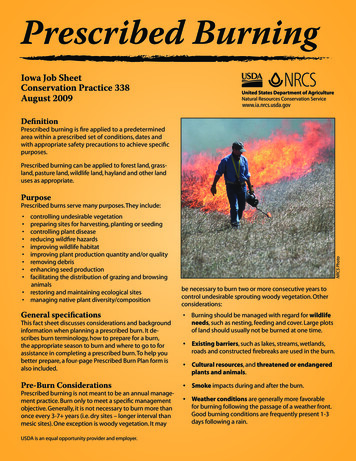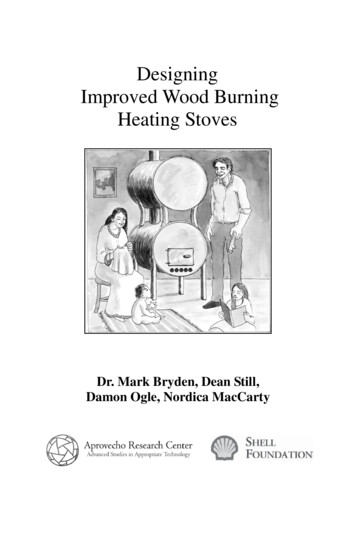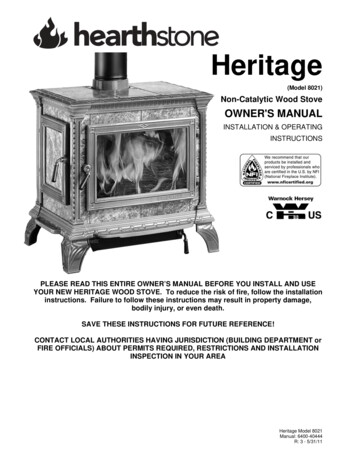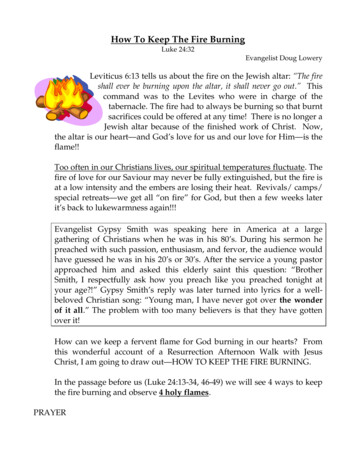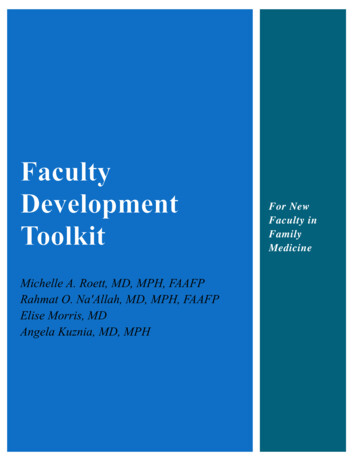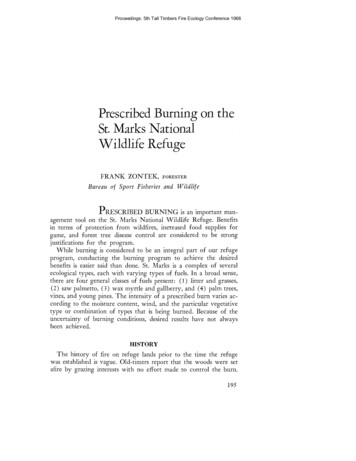
Transcription
Proceedings: 5th Tall Timbers Fire Ecology Conference 1966Prescribed Burning on theSt Marks NationalWildlife RefugeFRANK ZONTEK,FORESTERBureau of Sport Fisheries and WildlifePRESCRIBED BURNING is an important management tool on the St. Marks National Wildlife Refuge. Benefitsin terms of protection from wildfires, increased food supplies forgame, and forest tree disease control are considered to be strongjustifications for the program.While burning is considered to be an integral part of our refugeprogram, conducting the burning program to achieve the desiredbenefits is easier said than done. St. Marks is a complex of severalecological types, each with varying types of fuels. In a broad sense,there are four general classes of fuels present: (1) litter and grasses,(2) saw palmetto, (3) wax myrtle and gallberry, and (4) palm trees,vines, and young pines. The intensity of a prescribed burn varies according to the moisture content, wind, and the particular vegetativetype or combination of types that is being burned. Because of theuncertainty of burning conditions, desired results have not alwaysbeen achieved.HISTORYThe history of fire on refuge lands prior to the time the refugewas established is vague. Old-timers report that the woods were setafire by grazing interests with no effort made to control the burn.195
Proceedings: 5th Tall Timbers Fire Ecology Conference 1966FRANK ZONTEKSince marsh lands also provide browse for cattle they too wereburned.When the St. Marks and Panacea Units were brought into therefuge system in 1931 the practice of indiscriminate burning was discontinued. The Wakulla Unit was added to the refuge in 1936. Allmerchantable timber had been removed from refuge lands immediately prior to acquisition or in the case of the Wakulla Unit, a timberreservation was given to the owner from whom the land was purchased to permit him to remove additional timber. The refuge wasthus largely dominated by newly established stands of timber andthere was a need for complete protection from fire during the earlyyears. During the period 1931 to 1941 about 300 miles of fire breakswere plowed and maintained to protect against wildfires. Even so,fires did occur and in one case a fire burned out of control for threedays.As the extent and frequency of fires were reduced on the refugeby improved protection, a decided decrease in the upland game populations and in waterfowl use of the marshes became evident. It soonbecame apparent that burning could be an important managementtool in maintaining desirable habitat conditions for both upland gameand waterfowl. The first recorded prescribed burn on the refuge wasan experimental marsh burn accomplished during the 1940-41 winterseason. One hundred twenty acres were burned and good goose usewas reported on the new growth.BURNING PROGRAMWith the recognition that fire could be beneficial as a managementtool if used properly, a formal plan for burning was adopted. Theplan was broad in scope, reflecting the benefits that could be derivedif the program were carried out on a continuing basis. For each burn,the plan called for a detailed reporting of wind direction, windvelocity, and time of day, followed by information relative to thenumber of miles of control lines plowed, the man-hours worked andthe acreage burned. From these data evolved improved burningprocedures and a more efficient operation. Experience gained by196
FIG. 1. Prescribed burning marshland on St. Marks Refuge. Angle of the smokeindicates ideal wind conditions.25 years of burning serves as the basis for the procedures which weuse today.WEATHERWhat may be ideal burning weather five miles north of the refugeis not necessarily true for the refuge. It has been our experience thatthe nearer one is to the Gulf of Mexico, the more variable weatherconditions become. The staff members most familiar with theSt. Marks burning program say, "If the wind does not change by2 o'clock it will hold for the remainder of the day." The saying hasmerit. However, with so many variables to consider, you might saythat our burning program can be likened to the old-time bush pilotswe are flying by the seat of our pants.When the weather reports are favorable for burning the followingprocedure is used. The crew is alerted on days that are· predicted tobe ideal. One man obtains the weather data and visits the area. prepared for burning. The moisture content of the fuel is checkedand a judgment is made regarding wind direction and velocity. Ifconditions appear stable, the crew is dispatched to the burning area.No burning is done without a standby fire suppression unit and197
FIG. 2. Appearance of marshland immediately after burning. A good stand of wildmillet (Echinochloa waken) followed this burn.without first firing a control line to observe the fire's behavior. Whenconditions have been determined satisfactory, the remainder of thecontrol lines are set. If the behavior of the fire is contrary to whatis expected, the fire is suppressed.REFUGE UNITS-ST. MARKSOf the three units on the refuge, the St. Marks Unit accumulatesthe greatest tonnage of fuel over a given period. Four broad ecological types occur on this unit: (1) Pine Flatwoods, (2) HardwoodHammocks, (3) Fresh Water Marshes, and (4) Salt Water Marshes.Due to the fuel associated with this area, only back fires are used,except in some of the isolated areas where access is by boat. Theisolated wooded areas are burned with head fires, following a substantial rain. Fresh water and salt water marshes are also burnedwith head fires. Even with the ability of the land to produce anabundance of fuel, it is not possible to conduct a burn every year.Where there is a heavy cover of palmetto, a three-year accumulation of fuel is normally required for a successful burn. This also198
FIG. 3. Same area as Figure 2 after flooding. Waterfowl utilization of wild milletand other aquatic vegetation continued good for two years.holds true for the two types of marshes. For example, two individualmarshes were burned in 1964 and another burn would have beendesirable on each in 1965 . Two attempts were made in 1965 on thefirst area without success. Three attempts were made to burn thesecond area, and results were a 25 per cent burn.WAKULLA UNITOn the Wakulla Unit, where elevations are higher, the vegetativetypes consist of: (1) Deep Sand Ridges, (2) Hardwood Hammocks,(3 ) Pine-Live Oak Ridges, (4) Pine Flatwoods, and (5) Salt WaterMarshes. The fuel accumulates fairly heavily but cannot be burnedexcept on a three-year rotation. Back fires are used in the woodedareas while head fires are used on the marshes.PANACEA UNITThe Panacea Unit is composed for the most part of deep sandridges interspersed by fresh water lakes and ponds. Most of the fuel199
FRANK ZONTEKon. this unit is light, and as a result, does not generate much heat.With this type situation, most of the acreage can be burned with ahead fire. We believe that it is advantageous in most instances to burnwith a head fire, to push the fire through the thick growth of titiwhich grows around the perimeter of the lakes and ponds. Thesawgrass marshes also burn best with a head fire.The Panacea Unit is currently being restocked. The plan callsfor a regeneration of the longleaf pine-scrub oak ridges on a 60-40basis. This is to provide a basal area of 60 per cent pine and 40per cent oaks. This distribution will permit orderly burning andwill provide for the m intenance of an adequate mast crop for wildlife.WILDLIFE BENEFITSPrescribed burning is also a management tool which benefits waterfowl. Our records show that geese prefer marsh areas which havebeen burned. Burning, followed by flooding, is a technique oftenemployed to retard or control pest plants in fresh and brackishwater marshes. The effectiveness of fire in marsh management oftendepends on the ability to flood burned marshes before new growthstarts.Other forms of wildlife gain tremendously by burning. The historyof wildlife populations on the Wakulla Unit clearly shows the benefits of fire when used judiciously. In the early days of the refuge,with complete protection from fire, this unit supported decreasingpopulations of upland game species.A study of the turkey population in the early 1940's revealed thatturkeys seemed to prefer lands outside the refuge boundary whichwere being burned to improve conditions for cattle and hogs. Afterprescribed burning practices were initiated on the refuge, a notedincrease in the turkey population was observed.The Panacea Unit has been the best upland game area on therefuge. Although protected from fire, .the deep sand ridges affordfair habitat. It is our hope that forest game populations can beraised by restoring the area to a 60-40 ratio of pine and oak. This200
BURNING ON ST. MARKS REFUGEshould be particularly beneficial to the fox squirrel which prefersmature pine woods.The St. Marks Unit has the ability to produce an abundance offuel and as a result of prescribed burning, game populations are increasing. Very little turkey sign has been observed in this unit untilrecent years. The increases are credited to the burning program.The deer population also appears to be on the increase.ATTITUDESAs with every endeavor, there are those who are in favor ofburning and those who are opposed. Some of the most severecriticism of our burning program has come from ornithologists andsight-seers. Whenever possible, these persons are shown a comparisonof bird life on unburned and burned areas, after which they oftenadmit that a burning program has merit. Criticism has also come fromforesters who do not like to see seared trees. It is estimated thatless than one per cent of the seared trees are lost. The trees that do dieare often stagnated or suppressed and we do not consider such lossessignificant.In summary, it has been demonstrated that the benefits derivedfrom a prescribed burning program are definitely significant fromboth a wildlife and a timber management standpoint. Prescribedburning at St. Marks accomplishes the following:1. Reduces wildfire hazards.2. Improves conditions for wildlife by:(a) reducing the dense ground growth of perennial grasses andshrubs, leaving conditions suitable for legumes and annualweeds to become established.(b) removing small understory pines and hardwoods that areof little value either for game or for timber.3. Controls brown spot disease in young longleaf pine stands.4. Fits well into a multiple-purpose timber and wildlife management program.201
Prescribed burning marshland on St. Marks Refuge. Angle of the smoke indicates ideal wind conditions. 25 years of burning serves as the basis for the procedures which we use today. WEATHER What may be ideal burning weather five miles north of the refuge is not necessarily true for the refuge. It has been our experience that

